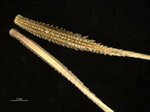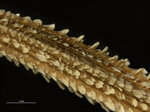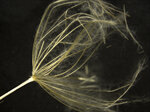Taxonomy
Tragopogon dubius Scop., Fl. Carniol., ed. 2. 2: 95. 1772.Common name
Yellow salsify, western salsify, western goatsbeard, wild oysterplant, salsify
Description
Propagule or dispersal unit is the fruit with pappus. Fertile part 10-16 mm long, 1-2 mm wide, in side view widest in lower part (ovoid) or widest in the middle, +/- straight or conspicuously curved, the upper (apical) end narrowing, in cross-section round (terete) (by misinterpretation) or angular (prismatic), basal scar (carpopodium) pronounced and well-differentiated or inconspicuous and undifferentiated, off to the side (oblique) or at least asymmetric, beak (=thinner sterile stalk between seed and pappus) present, beak length 10-17 mm, wings absent, fruit surface light brown or straw, smooth (except at cellular level), with no hairs (glabrous), thickened margin absent, longitudinal ribs present, 10-13, their surfaces smooth or toothed, serrated or scale-like, with no hairs (glabrous).
Pappus type bristles / hairs, pappus elements all +/- similar, up to 20-35 mm long, in several rows, pappus elements numerous, persistent (by misinterpretation) or falling off as a whole, the individual bristles feathery (plumose) along most of length, +/- equal width along length, white / translucent or brown.
Notes: The pappus breaks off easily at the base, so it may be missing. The two species of Tragopogon included in this key have very similar fruits and are hard to separate. It appears that Tragopogon dubius may have ten or more longitudinal ribs whereas Tragopogon porrifolius has less, but the number of ribs can also be hard to define especially on the smoother fruits.
Ecology
Annual to biennial herb, fruit wind-dispersed. Temperate regions. Found on rail- and roadsides, grasslands, wastelands, pastures, gardens, urban areas.
Native range
Europe, western Asia.
Introduced range
Canada, United States, Chile, Argentina, South Africa, Pakistan, Australia, New Zealand.
Past interceptions (Australia): origins
Other or unidentified species of the genus from Canada, Germany, China.
Past interceptions (Australia): commodities
Other or unidentified species of the genus in/on steel, used machinery and parts, new vehicles.


